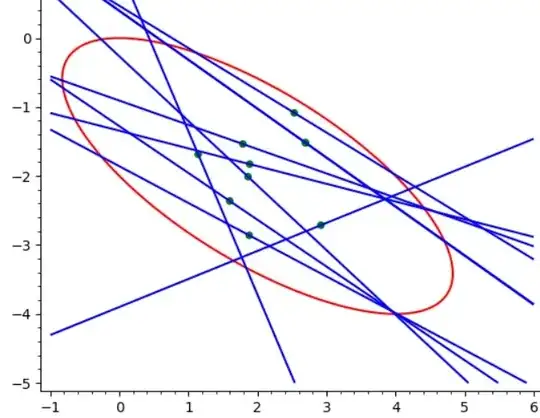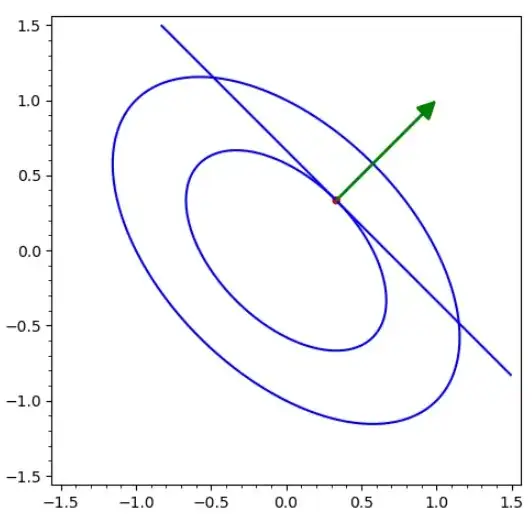Here is a graphical representation in the case of an ellipse :

*Fig. 1.$
- First version : analytic geometry calculations.
Being given the equation of the conic
$$ax^2 + 2hxy + by^2 + 2gx + 2fy + c\tag{*}$$
Let $U=\pmatrix{u\\v}$ be a directing vector of the chord, allowing its parameterization under the form :
$$\begin{cases}x&=&x_1+pu\\y&=&y_1+pv\end{cases}\tag{**}$$
The coordinates $(x,y)$ of the intersection points $P_1$ and $P_2$ of the chord with the conic curve will verify the expression obtained by "plugging" the expressions of $x$ and $y$ given by (**) into (*) giving rise to a quadratic polynomial in variable $p$:
$$Ap^2+2Bp+C=0 \ \text{with} $$ $$\begin{cases}A&=&au^2 + 2huv + bv^2\\B&=&
u(ax_1+hy_1+g)+v(hx_1+by_1+f)\\C&=&ax_1^2 + 2hx_1y_1 + by_1^2 + 2gx_1 + 2fy_1 + c\end{cases}\tag{1}$$
Observe now that point $P_1$ is the midpoint of the chord iff the intersection points $Q$ and $Q"$ correspond to two opposite values of $p,-p$. It amounts to say that the sum of the roots of quadratic equation (1) is equal to zero, otherwise said that the central coefficient $2B$ is zero.
Relationship $B=0$ considered as a dot product equal to $0$ expresses the geometrical fact that :
$$U=\pmatrix{u\\v} \ \text{is orthog. to} \ N:=\pmatrix{ ax_1+hy_1+g\\hx_1+by_1+f}\tag{2}$$
$N$ being a normal vector to the chord, the equation of this chord is :
$$(x-x_1)(ax_1+hy_1+g)+(y-y_1)(hx_1+by_1+f)=0\tag{3}$$
Besides, equation $T=S_1$, when expanded, is :
$$axx_1 + h(xy_1+x_1y) + byy_1 + g(x+x_1) + f(y+y_1) + c=ax_1^2 + 2hx_1y_1 + by_1^2 + 2gx_1 + 2fy_1 + c\tag{4}$$
which can be put under the form :
$$x(ax_1+hy_1+g)+y(hx_1+by_1+f)=x_1(ax_1+hy_1+g)+y_1(hx_1+by_1+f)\tag{5}$$
Now compare (3) and (5).
Second version, with a vectorial formulation
having the advantage of more compact notations.
Expression (*) can be given the form of a quadratic equation under the form :
$$X^TQX+2V^TX+c=0 \ \text{with} \ Q=\pmatrix{a&h\\h&f}, \ \ V=\pmatrix{g\\f}, \ X=\pmatrix{x\\y}\tag{6}$$
Expression (**) becomes $X=X_1+pU$ ; plugging it into (6) gives :
$$(X_1+pU)^TQ(X_1+pU)+2V^T(X_1+pU)+c=0$$
$$X_1^TQX_1+2pU^TQX_1+p^2U^TQU+2V^TX_1+2pV^TU+c=0$$
$$p^2 \underbrace{U^TQU}_A + 2p\underbrace{U^T(QX_1+V)}_B+\underbrace{(X_1^TQX_1+c)}_C=0$$
It is exactly numerical quadratic equation (1) (check it !). In particular, setting the coefficient $2B$ of $p$ to $0$, as before, we retrieve the fact that vector $U$ is orthogonal to :
$$QX_1+V=\pmatrix{a&h\\h&f}\pmatrix{x_1\\y_1}+\pmatrix{g\\f}=\pmatrix{ax_1+hy_1+g\\hx_1+by_1+f}\tag{7}$$
as obtained in (2).
Besides, let us express $S_1$ and $T$ under their resp. vectorial expressions :
$$\begin{cases}S_1 &:& X_1^TQX_1+2 X_1^TV+c\\T &:& X^TQX_1+ (X+X_1)^TV+c\end{cases}$$
Equating them, and simplifying, we get :
$$(X-X_1)^TQX_1+(X-X_1)^TV=0$$
$$(X-X_1)^T(QX_1+V)=0$$
which is the equation of a line passing through $X=X_1$ with normal vector $QX_1+V$ as "imposed" by (7) ! QED.
Edit : I answer your question about the fact that the normal vector to the chord is "rather surprisingly"
$$QX_1+V$$
i.e., equal (up to a $2$ factor) to the gradient of expression (6) computed in point $X_1$.
Have a look at figure 2 featuring a conic curve, and a point $X_1$ which is the midpoint of a chord found by the $T=S_1$ method

Fig. 2. Homothetic curves $Q(x,y)=1$ and $Q(x,y)=1/3$ with $Q(x,y)=x^2+xy+y^2$ and $(x_1,y_1)=(1/3,1/3)$.
This chord is in fact tangent to a homothetical ellipse to the initial ellipse : no surprize that the gradient at point $X_1$ is orthogonal to the tangent to the curve.

